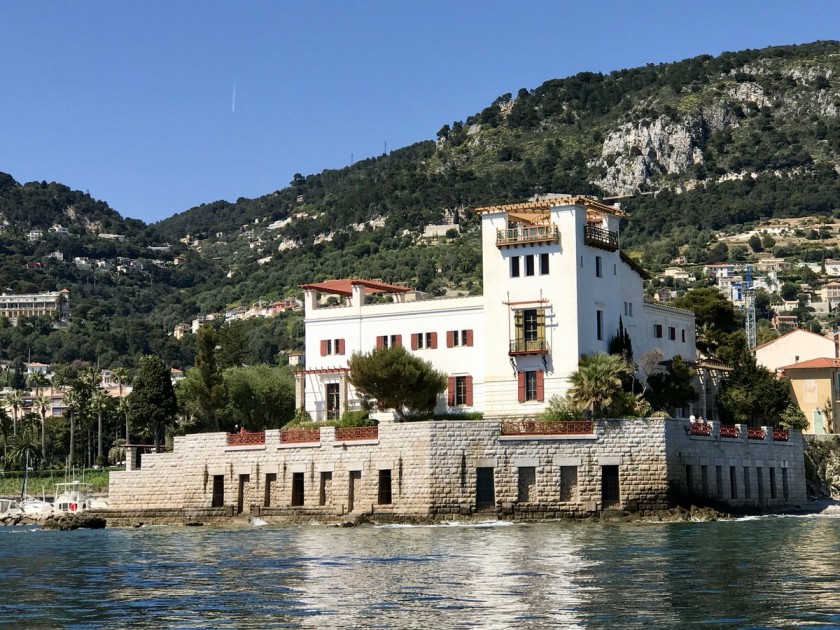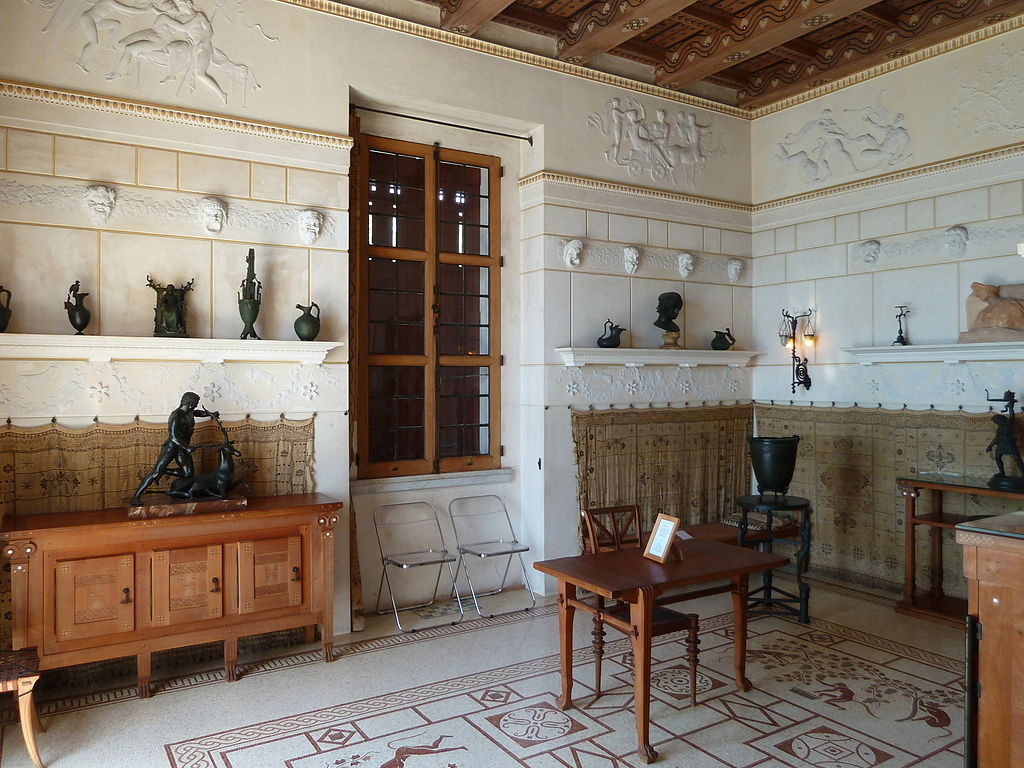
Villa Kérylos, French Riviera
My love affair with the extraordinary house at the heart of my novel, Villa of Delirium, arose from a scholarly conference organized by the French learned society, the Academy of Inscriptions and Belles Lettres. Like many devotees of art and history, I knew of this incredible residence, the Villa Kérylos located between Nice and Monaco on the fabled Côte d’Azur, but during the time that I spent at this conference, I got to know it in a very real way. I came to understand that this “Greek villa,” as it is called, is not simply a museum — even if countless visitors have the opportunity to visit it each year.
The Academy of Inscriptions holds its largest annual conference in this little paradise in memory of Théodore Reinach, the great Hellenist who built it at the start of the twentieth-century. Upon his death in 1928, he bequeathed the property to the Institut de France, a highly original French invention that comprises the Academy of Inscriptions and four other academies, housing them altogether in Paris under the dome of the Palais Mazarin, facing the Louvre Museum on the opposite site of the Seine.
Other conferences have been held at the Villa Kérylos where under the Mediterranean sun they have also probed great moments of intellectual and cultural life. In 2019, the Jewish Country House Conference convened in the former Reinach residence to consider the fascinating theme of “the grand Jewish bourgeoisie in the countryside: their networks, families and patrimony.”
During those days when I listened to impassioned presentations, I had time to explore the premises: the sea and the rocks, the small beach, the salons decorated as if by an architect from antiquity brought back to life in modern times to fulfill the vision of a wealthy and cultivated man — who also needed central heating and a piano. The villa is perfection, a dream vision of antiquity revived and conceived by the architect and archaeologist Emmanuel Pontremoli in whom Reinach found his ideal counterpart for this endeavor.
The villa is perfection, a dream vision of antiquity revived and conceived by the architect and archaeologist Emmanuel Pontremoli in whom Reinach found his ideal counterpart for this endeavor.

Inside Villa Kérylos
I saw harmony and elegance, the intelligent fulfillment of the ensemble’s conception in the treatment of every detail, every door, every lamp, as a work of art that makes up a larger creative piece. Kérylos is not a Greek pastiche or an imitation of a house from antiquity; it’s a brilliant reinvention. Above all, I grew fond of Théodore Reinach and his two brothers, Joseph and Salomon, the most cultivated men of their generation. They were not at all backward looking. Their profound love of ancient culture made them staunch defenders of democracy. They energetically rallied behind Captain Alfred Dreyfus when he was court-martialed for treason in the scandal that seized all of France. They felt compelled to combat antisemitism, having studied what they called la tradition juive.The brothers were not at all observant but were interested in Jewish texts and archaeology, and they played an essential role in France’s very important Society of Jewish Studies when it was conceived in the late nineteenth-century.
Théodore Reinach seemed to me like the hero of a novel, someone who knew everyone significant of his day, from the author Émile Zola to the composer Gabriel Fauré; I didn’t invent his life, I wanted to be faithful to what it was. For that reason, I created other figures who inhabited his house — notably Achilles, a young man whose mother was a cook in a neighboring villa, the home of Gustave Eiffel, that also still stands today. Eiffel didn’t want to create a tower of metal, but a solid palace in Italian style poised at the water’s edge. The young Achilles falls in love with the wife of one of Eiffel’s architects; Achilles also falls in love with literature and antiquity. His destiny is transformed by this house that so amazes him.
Eiffel didn’t want to create a tower of metal, but a solid palace in Italian style poised at the water’s edge.
I also wanted to recount the era from the Dreyfus Affair to World War II. Léon, the son of Théodore Reinach, married Béatrice de Camondo, daughter of Moïse de Camondo — the creator of another celebrated house which has become a museum, the Musée Nissim de Camondo, on the border of the Parc Monceau, where one lived in the midst of the art of the eighteenth- century as one lived at Kérylos with the spirit of Greek antiquity. Léon and Béatrice Reinach, like their two children Fanny and Bertrand, were all murdered in Auschwitz and the villa on the Riviera was ransacked by the Nazis.
But as part of my research I met with other descendants of the family who survived the Holocaust, and the Villa Kérylos itself endures, an expression of Théodore Reinach, with all his humor, his fine mind, his manifold talents, and the tenderness he had for his family. His passion, political and artistic, is visible in the architecture of this dream world that remains open to all to this day.
Adrien Goetz, author of Villa of Delirium, teaches art history at the Sorbonne in Paris. He is editor of Grande Galerie, the quarterly magazine of the Louvre Museum.